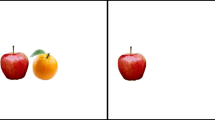Abstract
Estimating distance of objects relative to one’s body is important for interaction with the environment. Given that distance is an interval of magnitude describing space, distance and the commonly used estimations of magnitude, i.e., numbers, may share a common representation system (the ATOM theory, Walsh in Trends Cogn Sci 7(11):483–488, 2003). The current study systematically examined the association between distance and number representations on both the sagittal and transverse axes on the transverse plane in the peripersonal space. Participants in Experiment 1 judged the parity of digits by pressing one of two buttons (both were in front of participants): One was near the body and the other away from it. We found that near responses were faster when paired with smaller numbers and far responses with larger numbers. When one button was set in front and the other in back in Experiment 2, no mapping was found. In Experiment 3, when both buttons were on the right side aligned with the transverse axis, small-near and large-far mapping were found. However, no such effect was found on the left side. These results suggest that numbers are mapped onto the whole transverse plane of the peripersonal space, not only a left–right oriented number line.




Similar content being viewed by others
Notes
In the following text, if it is not specifically indicated, “distance” refers to the distance relative to our body in the peripersonal space. It should be distinguished from the physical distance between two arbitrary objects or the mental distance between two numbers, because what we are interested in is the distance representation in the peripersonal space which serves for our limb movements, rather than the domain-general spatial representation.
References
Andres M, Davare M, Pesenti M, Olivier E, Seron X (2004) Number magnitude and grip aperture interaction. NeuroReport 15(18):2773–2777
Bueti D, Walsh V (2009) The parietal cortex and the representation of time, space, number and other magnitudes. Philos Trans R Soc Lond B Biol Sci 364(1525):1831–1840. doi:10.1098/rstb.2009.0028
Cardinali L, Brozzoli C, Farne A (2009) Peripersonal space and body schema: two labels for the same concept? Brain Topogr 21(3–4):252–260. doi:10.1007/s10548-009-0092-7
Cipolotti L, Butterworth B, Denes G (1991) A specific deficit for numbers in a case of dense acalculia. Brain J Neurol 114(Pt 6):2619–2637
Cohen J (1988) Statistical power analysis for the behavioral sciences, 2nd edn. Lawrence Erlbaum Associates, Hillsdale
Colby CL, Goldberg ME (1999) Space and attention in parietal cortex. Annu Rev Neurosci 22:319–349. doi:10.1146/annurev.neuro.22.1.319
Dehaene S, Cohen L (1997) Cerebral pathways for calculation: double dissociation between rote verbal and quantitative knowledge of arithmetic. Cortex 33(2):219–250
Dehaene S, Bossini S, Giraux P (1993) The mental representation of parity and number magnitude. J Exp Psychol Gen 122(3):371–396
Dehaene S, Spelke E, Pinel P, Stanescu R, Tsivkin S (1999) Sources of mathematical thinking: behavioral and brain-imaging evidence. Science 284(5416):970–974
Di Luca S, Grana A, Semenza C, Seron X, Pesenti M (2006) Finger-digit compatibility in Arabic numeral processing. Q J Exp Psychol 59(9):1648–1663
Dodd MD, Van der Stigchel S, Leghari MA, Fung G, Kingstone A (2008) Attentional SNARC: there’s something special about numbers (let us count the ways). Cognition 108(3):810–818
Fischer MH (2012) A hierarchical view of grounded, embodied, and situated numerical cognition. Cogn Process 13:161–164
Fischer MH, Castel AD, Dodd MD, Pratt J (2003) Perceiving numbers causes spatial shifts of attention. Nat Neurosci 6(6):555–556. doi:10.1038/nn1066
Gevers W, Lammertyn J (2005) The hunt for SNARC. Psychol Sci 47(1):10–21
Holmes NP, Spence C (2004) The body schema and the multisensory representation(s) of peripersonal space. Cogn Process 5(2):94–105. doi:10.1007/s10339-004-0013-3
Hubbard EM, Piazza M, Pinel P, Dehaene S (2005) Interactions between number and space in parietal cortex. Nat Rev Neurosci 6(6):435–448
Hung YH, Hung DL, Tzeng OJL, Wu DH (2008) Flexible spatial mapping of different notations of numbers in Chinese readers. Cognition 106(3):1441–1450
Ito Y, Hatta T (2004) Spatial structure of quantitative representation of numbers: evidence from the SNARC effect. Mem Cogn 32(4):662–673
Jonas CN, Spiller MJ, Jansari A, Ward J (2013) Comparing implicit and synaesthetic number–space associations: visuospatial and verbal spatial–numerical associations of response codes. Q J Exp Psychol. doi:10.1080/17470218.2013.856928
Klatzky R (1998) Allocentric and egocentric spatial representations: definitions, distinctions, and interconnections. In: Freksa C, Habel C, Wender K (eds) Spatial cognition, vol 1404. Springer, Berlin, pp 1–17
Müller D, Schwarz W (2007) Is there an internal association of numbers to hands? The task set influences the nature of the SNARC effect. Mem Cogn 35(5):1151–1161
Pinhas M, Tzelgov J, Ganor-Stern D (2012) Estimating linear effects in ANOVA designs: the easy way. Behav Res Methods 44(3):788–794
Rizzolatti G, Scandolara C, Matelli M, Gentilucci M (1981) Afferent properties of periarcuate neurons in macaque monkeys. II. Visual responses. Behav Brain Res 2(2):147–163
Rossetti Y, Jacquin-Courtois S, Rode G, Ota H, Michel C, Boisson D (2004) Does action make the link between number and space representation? Visuo-manual adaptation improves number bisection in unilateral neglect. Psychol Sci 15(6):426–430. doi:10.1111/j.0956-7976.2004.00696.x
Saj A, Vuilleumier P (2007) Neglect: remembering the space left behind. Curr Biol (CB) 17(24):R1060–R1062. doi:10.1016/j.cub.2007.10.016
Salillas E, El Yagoubi R, Semenza C (2008) Sensory and cognitive processes of shifts of spatial attention induced by numbers: an ERP study. Cortex 44(4):406–413. doi:10.1016/j.cortex.2007.08.006
Schwarz W, Keus IM (2004) Moving the eyes along the mental number line: comparing SNARC effects with saccadic and manual responses. Percept Psychophys 66(4):651–664
Walsh V (2003) A theory of magnitude: common cortical metrics of time, space and quantity. Trends Cogn Sci 7(11):483–488
Zorzi M, Priftis K, Umilta C (2002) Brain damage: neglect disrupts the mental number line. Nature 417(6885):138–139. doi:10.1038/417138a
Acknowledgments
This study is supported by a grant from National Science Council of Taiwan (MOST101-2410-H-002-083-MY3). We thank Ren-Hao Li for the initial discussion of the idea, and Jye-Sheng Tan and An-Yi Chang for helpful comments on earlier versions of this manuscript.
Author information
Authors and Affiliations
Corresponding author
Rights and permissions
About this article
Cite this article
Chen, YH., Zhou, JF. & Yeh, SL. Beyond the SNARC effect: distance–number mapping occurs in the peripersonal space. Exp Brain Res 233, 1519–1528 (2015). https://doi.org/10.1007/s00221-015-4225-9
Received:
Accepted:
Published:
Issue Date:
DOI: https://doi.org/10.1007/s00221-015-4225-9




